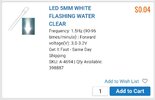You keep pushing this block coding but I haven't seen any examples?
Sounds like bloat ware to me, or is it?
Mike.
MIT major proponent, Scratch and it has several spinoffs, use your browser and
google block "programming language", google produced 218,000,000 hits.....
Google also working on it, Blockly.....
The idea behind block programming is to remove the rigid constraints imposed by
C and C++ from user. And address visual learners. Not perfect, neither is C or C++.
Kids in 6'th grade programming robots with it. My grandson has done some simple
stuff with it both in school and with me. His school started him age 7 I think. And
it allows users to look at C/C++ generated, a bridge.......
Post on these various websites and ask how many downloads, not a precise answer
but certainly one more datum of usage.......
You keep pushing this block coding but I haven't seen any examples?
Post # 14 I showed links to 2 applications. Here is one for web work :
Had a problem with a remote site, property management. Basically wanted to run Network on site with a Cell based solution. Key issues : 1) Hotspot, if it lost power and ran batteries completely down would not boot all the way into Cell tower connection. It would charge on power return (its...

www.edaboard.com
Note I keep seeing people pushing PIC, when they could be using an SOC that has
logic level elements, DSP, 20 bit DelSig, SAR, OpAmps, Mixers, routable, custom user generated
onchip components as well, LUTs, Display......but I know folks in my profession, who never
emerged from the vacuum tube era. To be human is to be imperfect.

Regards, Dana.




